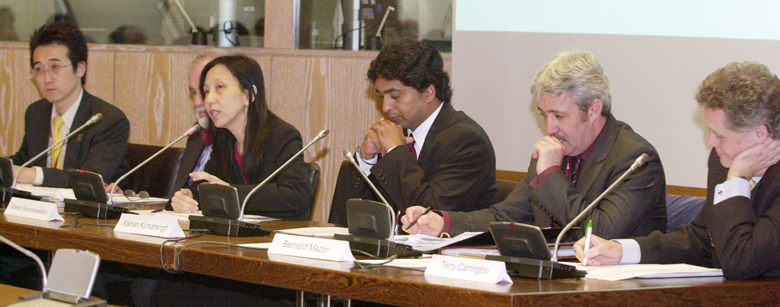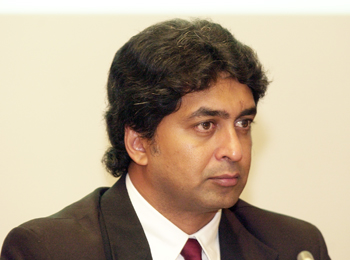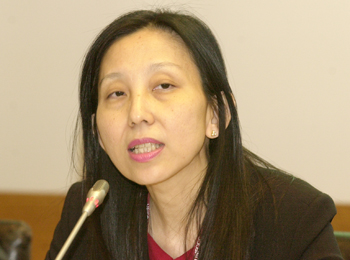 |
||
|
Published by the International Institute for Sustainable Development (IISD)
in cooperation with the UNFCCC Secretariat |
|||
|
Special Report on Selected Side Events at SB 24
|
|||||
| 15-26 May 2006 | Bonn, Germany | |||||
 |
|||
 |
|||
Events convened on Thursday, 18 May 2006
|
2006 IPCC guidelines for National Greenhouse Gas Inventories Presented by the Intergovernmental Panel for Climate Change |
||||
|
Jim Penman, UK Department for Environment, Food and Rural Affairs, provided an overview of the origins, structure and approach of the 2006 IPCC guidelines for National Greenhouse Gas (GHG) Inventories. Noting that they cover five volumes, he described some of the new developments, including: coverage of all GHG gases with global warming potential (GWP); estimation methods for carbon capture and storage; and introduction of annual and direct emission estimates. Newton Paciornik, Brazilian Ministry of Science and Technology, presented the volume on General Guidance, explaining it contains guidance on the principles applied through different sectors such as transparency, completeness, consistency, comparability and accuracy. Tinus Pulles, TNO Built Environment and Geosciences, said new developments in the volume on Energy include: achieving a clear separation between the sectoral and reference approach in estimating emissions; improving clarity on non-energy use of fuels; and including estimation methods for carbon capture and storage and methane from abandoned coal mines. Jochen Harnisch, Ecofys, highlighted that the volume on Industrial Processes and Product Use includes guidance on emissions from: new sources in the chemical industry; zinc, lead and ferro-alloys in the metal industry; and photovoltaic cells in the electronics industry. N.H. Ravindranath, Indian Institute of Science, listed some advances in the Agriculture, Forestry and Other Land-Use (AFOLU) volume, inter alia: the integration of agriculture and land-use change and forestry; the adoption of six land-use categories; the incorporation of key category analysis; and the consistent classification of land uses. Keith Paustian, Colorado State University, added that the volume contains guidance on emission estimation from diverse land uses such as pasture and managed rangelands, flooded lands and lands managed for peat extraction. Riitta Pipatti, Statistics Finland, noted that the volume on Waste contains improved and new guidelines on estimating emissions from solid waste disposal, wastewater treatment and discharge, biological treatment of solid waste and on incineration and open burning of waste. Taka Hiraishi, IPCC Task Force on National GHG Inventories, highlighted that using new guidelines is each Parties’ responsibility and there is high intersectoral collaboration between the five volumes. Participants discussed accuracy of future inventories, implementation of new guidelines, consistency between old and new inventories, need for improved data collection in developing countries and issues relating to guidelines on wetlands. |
||||
|
|||
|
Strategies for the future climate framework: highlights from CCAP’s recent Future Actions Dialogue Presented by the Center for Clean Air Policy |
|||
|
Jake Schmidt, Center for Clean Air Policy (CCAP), outlined a proposal for stabilizing global emissions post-2012 through sector targets for major industries in developed and developing countries. He explained this bottom-up approach aims at encouraging developing countries to make sectoral GHG intensity pledges in key industrial sectors. Schmidt added that developing countries would receive technology incentives from developed countries and international financial institutions to adopt more aggressive targets. He noted that inclusion of the ten largest GHG emitting developing countries in each sector would ensure coverage of 80-90% of GHG emissions from all developing countries in each of the selected sectors. He emphasized that reductions achieved beyond the voluntary pledges would be eligible for sale as emissions reductions credits to developing countries and failure to meet the pledge level would not involve penalties.
Edward Helme, CCAP, informed that his organization is concluding the third year of its Dialogue on Future International Actions to Address Global Climate Change, which brings together senior climate change negotiators from over 30 developed and developing countries to identify and discuss options for the post-2012 regime. He provided an overview of the implications of the ‘no lose’ voluntary targets for the transportation sector, noting that almost 80% of the global vehicle fleet is produced by 15 companies in nine countries. He stressed that efficiency improvements can be counteracted by increased vehicle weight and performance as well as additional amenities. He indicated that the CCAP technology-based sectoral proposal received positive feedback during the Dialogue. Fernando Tudela, Ministry of Environment and Natural Resources, Mexico, called for transcending the project-based approach by adopting a sectoral approach to emission reductions. He explained that the “no lose” targets are linked to the nature of unstable economies in developing countries, where paying a penalty for non-compliance would be politically unacceptable. He underscored that a recent study in Mexico suggested that converting to higher diesel technology is cost effective in light of the health cost savings such a conversion would create. He added that carbon finance would help developing countries reduce their emissions further and faster. Participants discussed the number of benchmarks needed to capture the major industrial processes, ways in which energy intensity benchmarks can address competitiveness issues and compared savings achieved by upgrading technology and improved driving conditions. |
|||
|
|||
|
Current operation and future developments of the CITL and ITL Presented by the European Community |
|||
|
Andrew Howard, UNFCCC Secretariat, discussed the implementation of the International Transaction Log (ITL), which acts as a communications hub that connects all registries. He explained that the ITL checks transactions against technical standards and policy-related rules, and feeds EU transactions to the Community Independent Transaction Log (CITL) for supplementary checking. He said it safeguards the integrity of Kyoto compliance accounting by controlling that transactions conform to Kyoto Protocol rules and tracks international movement of emission allowances. Noting that the ITL is only required to be operational by the 2008-2012 commitment period, he stated that under the EU Emissions Trading Scheme (EU ETS) the ITL allows CDM project credits to be used by EU companies, pushing the operational date to April 2007 for linking the national registries.
Howard emphasized that the ITL needs to be fully compatible with data exchange standards, and highlighted the Log’s characteristics, including its resilient architecture and size, which is designed to cope with the increase in the transactions rate of the carbon market. He indicated that the Secretariat is endeavoring to ensure that: the ITL is secure, reliable and available to support registries and the market; the EU ETS’ needs are fully integrated into Kyoto registries; and that the registry system administrators are becoming more established. Istvan Bart, European Commission, described the CITL, noting that it uses the same code as the ITL but differs from it functionally. He provided an overview of the EU ETS, highlighting that 22 of the 25 Member States have active registries, with 9,400 installations. He explained that the CITL checks and logs transactions between member State registries and provides a website that enables access to information on account holders’ allocations and verified emissions. He said the ITL would become a fundamental part of the EU ETS and emphasized that in light of the dependence of trading on the computer system, the latter has to be transparent, watertight, and stable. Participants discussed: exclusion of forestry credits under the EU ETS linking directive; whether EU ETS transactions will pass through the ITL; security differences between the CITL and ITL; and assigned amount units use in the second phase of the EU ETS. |
|||
|
|
|||
|
Broadening the base of financing for technology transfer Presented by the International Center for Environmental Technology Transfer |
|||
|
Elmer Holt, Climate Technology Initiative (CTI), noted the need to leverage public and private funding to meet technology transfer needs for climate change mitigation in developing countries.
Wanna Tanunchaiwatana, UNFCCC Secretariat, discussed lessons learned from workshops conducted by the Expert Group on Technology Transfer (EGTT) in Bonn and Montreal where financers and Parties discussed ways to link technology transfer projects with funding opportunities. Emphasizing that private sector funding exists to support technology transfer, she cited the lack of good project proposals as a barrier to tapping into this funding. She explained that EGTT’s future work will include coaching and training programmes for project developers in developing countries and the development of a practitioner’s guide on project proposal development. Kishan Kumarsingh, Chair of SBSTA-24, discussed actions needed to enhance private financing prospects and highlighted key messages from the two EGTT workshops, including the need for: capacity building for project developers; mobilizing local resources, including natural, human, institutional, and financial; considering technical and political risks; mobilizing domestic capital; and creating an investor-friendly environment. Bernard Mazijn, EGTT, discussed the need to create an enabling environment to involve the private sector and increase financing flows for technology transfer. He stated that the EGTT is currently working on a technical paper on innovative options for financing and a practitioner’s guide for project proposals, which aims at improving the likelihood of project financing, to be published at COP12. He highlighted the need for ODA to build capacity and increase the quality of Technology Needs Assessments to bridge the gap between project development and financing. Peter Storey, HERA International Group, emphasized that project developers need to consider the suitability of their projects for private funding at an early stage. He explained that the private sector looks for: consistent regulatory, legal and commercial frameworks; commercially and technically experienced project sponsors; use of proven technologies; repayment ability and security; risk sharing and diversification; and adequate returns. He highlighted the CTI’s Private Financing Advisory Network as a tool for helping project developers to determine and seek out appropriate sources of funding. Participants discussed various barriers to obtaining financing for projects, including: high relative transaction costs for small projects; development risks; and obtaining government guarantees. |
|||
|
|||
|
||
|
Click the above button to go back to our ENB main coverage
|
||
|
|
|
|
|
||
|

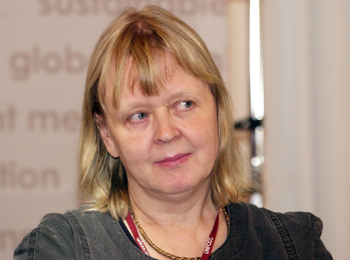
-tn.jpg)
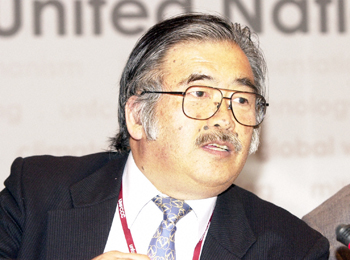
-tn.jpg)
-tn.jpg)
-tn.jpg)
-tn.jpg)
-tn.jpg)
-tn.jpg)
-tn.jpg)
-tn.jpg)
-tn.jpg)
-tn.jpg)
-tn.jpg)
